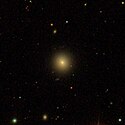IC 3653
| Galaxie IC 3653 | |
|---|---|
 | |
| SDSS-Aufnahme | |
| AladinLite | |
| Sternbild | Jungfrau |
| Position Äquinoktium: J2000.0, Epoche: J2000.0 | |
| Rektaszension | 12h 41m 15,7s [1] |
| Deklination | +11° 23′ 14″ [1] |
| Erscheinungsbild | |
| Morphologischer Typ | E3[1] |
| Helligkeit (visuell) | 13,8 mag[2] |
| Helligkeit (B-Band) | 14,8 mag[2] |
| Winkelausdehnung | 0,5′ × 0,5′[2] |
| Flächenhelligkeit | 12,4 mag/arcmin²[2] |
| Physikalische Daten | |
| Zugehörigkeit | Virgo-Cluster[1] |
| Rotverschiebung | 0.001961 ± 0.000013[1] |
| Radialgeschwindigkeit | (588 ± 4) km/s[1] |
| Hubbledistanz H0 = 73 km/(s • Mpc) | (24 ± 2) 𐄁 106 Lj (7,36 ± 0,52) Mpc [1] |
| Geschichte | |
| Entdeckung | Royal Harwood Frost |
| Entdeckungsdatum | 10. Mai 1904 |
| Katalogbezeichnungen | |
| IC 3653 • PGC 42550 • CGCG 070-215 • MCG +02-32-178 • 2MASX J12411572+1123138 • VCC 1871 • LDCE 904 NED222 | |
IC 3653 ist eine Elliptische Galaxie vom Hubble-Typ E im Sternbild Jungfrau nördlich der Ekliptik. Sie ist schätzungsweise 24 Millionen Lichtjahre von der Milchstraße entfernt, hat einen Durchmesser von etwa 4.000 Lj und ist unter der Katalognummer VVC 1871 als Teil des Virgo-Galaxienhaufens gelistet.
Im selben Himmelsareal befinden sich u. a. die Galaxien NGC 4621, NGC 4638, IC 3652, IC 3665.
Das Objekt wurde am 10. Mai 1904 von Royal Harwood Frost entdeckt.[3]
Weblinks
Einzelnachweise
Auf dieser Seite verwendete Medien
Autor/Urheber: Sloan Digital Sky Survey, Lizenz: CC BY 4.0

Angle of view: 4' × 4' (0.3" per pixel), north is up.
Details on the image processing pipeline: https://www.sdss.org/dr14/imaging/jpg-images-on-skyserver/